Marriott Hotel: Research Project on Staff Training and Development
VerifiedAdded on 2021/02/20
|29
|6152
|79
Report
AI Summary
This research project investigates the significance of staff training within the hospitality sector, using Marriott Hotel as a case study. The report delves into Marriott's organizational background, aims, objectives, and research questions related to the impact of training on customer satisfaction. It reviews relevant literature on staff training concepts, models (including the System and Kirkpatrick's models), and development theories. The research methodology, including the research onion, philosophy, approach, design, and data collection methods, is outlined. The report analyzes findings related to training's effect on customer service, incorporating the SERVQUAL model and discussing the importance of staff training and development. Finally, the conclusion summarizes the key findings, links them to the objectives, and provides recommendations, limitations, and suggestions for further study, referencing various academic sources throughout.
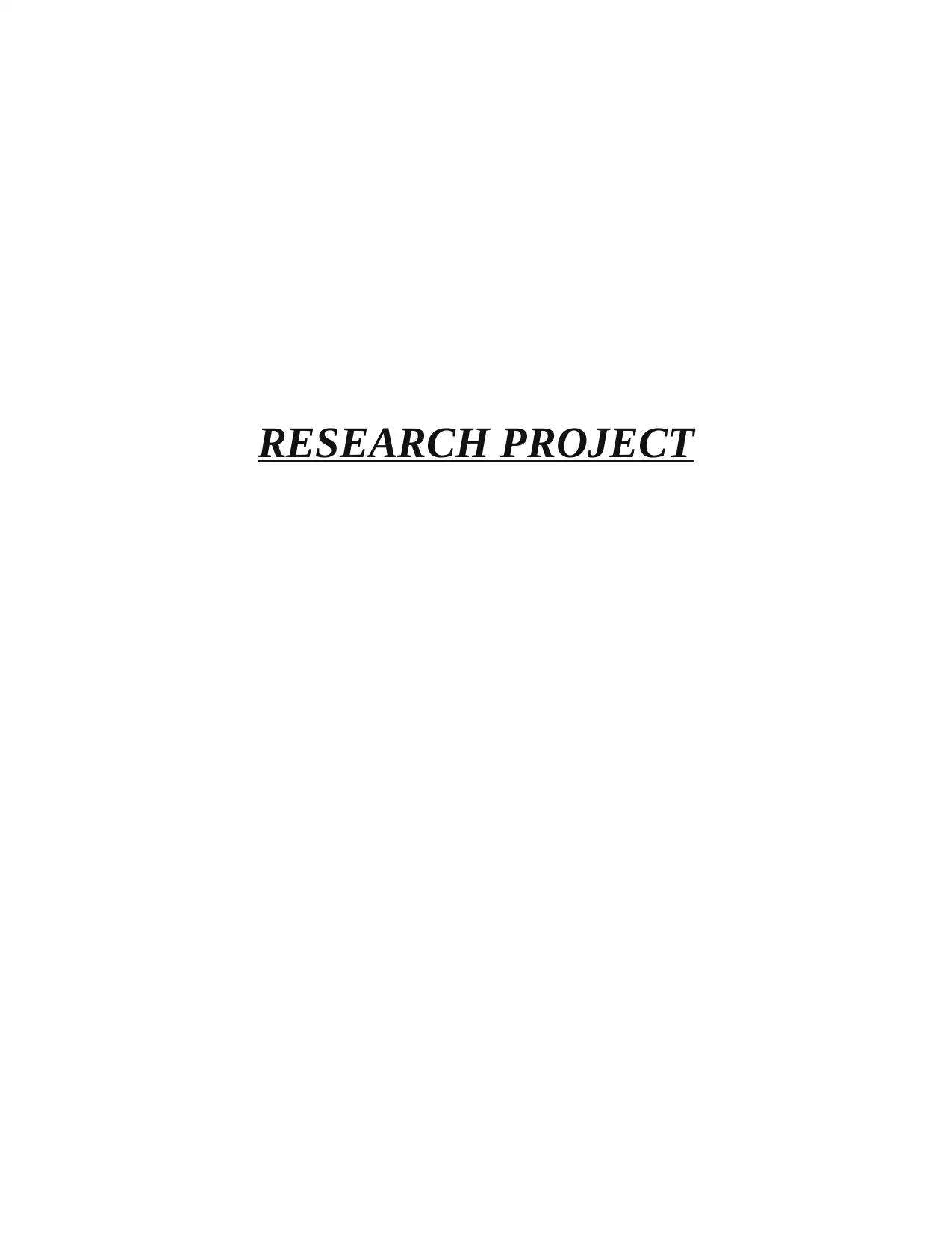
RESEARCH PROJECT
Paraphrase This Document
Need a fresh take? Get an instant paraphrase of this document with our AI Paraphraser
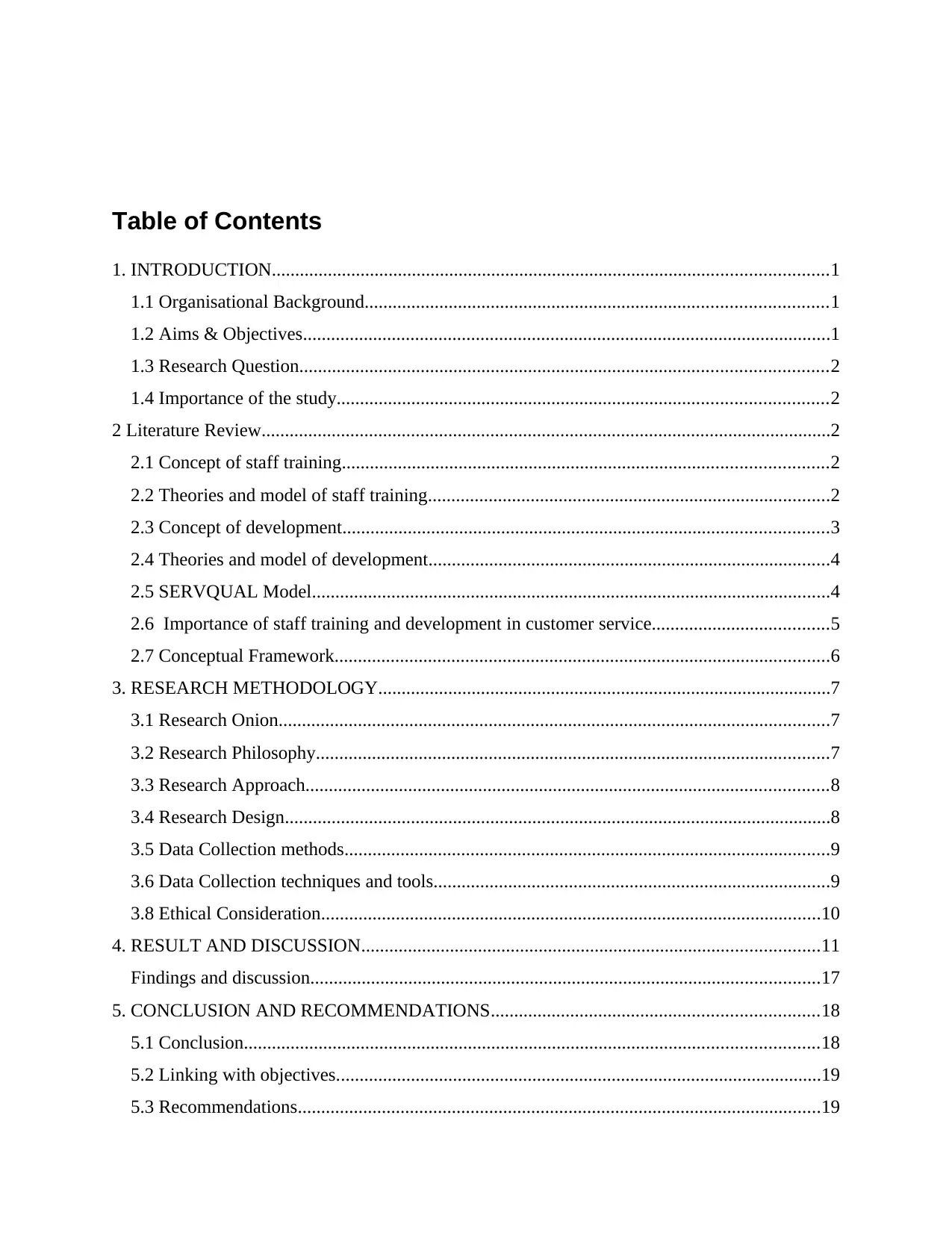
Table of Contents
1. INTRODUCTION.......................................................................................................................1
1.1 Organisational Background...................................................................................................1
1.2 Aims & Objectives.................................................................................................................1
1.3 Research Question.................................................................................................................2
1.4 Importance of the study.........................................................................................................2
2 Literature Review..........................................................................................................................2
2.1 Concept of staff training........................................................................................................2
2.2 Theories and model of staff training......................................................................................2
2.3 Concept of development........................................................................................................3
2.4 Theories and model of development......................................................................................4
2.5 SERVQUAL Model...............................................................................................................4
2.6 Importance of staff training and development in customer service......................................5
2.7 Conceptual Framework..........................................................................................................6
3. RESEARCH METHODOLOGY.................................................................................................7
3.1 Research Onion......................................................................................................................7
3.2 Research Philosophy..............................................................................................................7
3.3 Research Approach................................................................................................................8
3.4 Research Design.....................................................................................................................8
3.5 Data Collection methods........................................................................................................9
3.6 Data Collection techniques and tools.....................................................................................9
3.8 Ethical Consideration...........................................................................................................10
4. RESULT AND DISCUSSION..................................................................................................11
Findings and discussion.............................................................................................................17
5. CONCLUSION AND RECOMMENDATIONS......................................................................18
5.1 Conclusion...........................................................................................................................18
5.2 Linking with objectives........................................................................................................19
5.3 Recommendations................................................................................................................19
1. INTRODUCTION.......................................................................................................................1
1.1 Organisational Background...................................................................................................1
1.2 Aims & Objectives.................................................................................................................1
1.3 Research Question.................................................................................................................2
1.4 Importance of the study.........................................................................................................2
2 Literature Review..........................................................................................................................2
2.1 Concept of staff training........................................................................................................2
2.2 Theories and model of staff training......................................................................................2
2.3 Concept of development........................................................................................................3
2.4 Theories and model of development......................................................................................4
2.5 SERVQUAL Model...............................................................................................................4
2.6 Importance of staff training and development in customer service......................................5
2.7 Conceptual Framework..........................................................................................................6
3. RESEARCH METHODOLOGY.................................................................................................7
3.1 Research Onion......................................................................................................................7
3.2 Research Philosophy..............................................................................................................7
3.3 Research Approach................................................................................................................8
3.4 Research Design.....................................................................................................................8
3.5 Data Collection methods........................................................................................................9
3.6 Data Collection techniques and tools.....................................................................................9
3.8 Ethical Consideration...........................................................................................................10
4. RESULT AND DISCUSSION..................................................................................................11
Findings and discussion.............................................................................................................17
5. CONCLUSION AND RECOMMENDATIONS......................................................................18
5.1 Conclusion...........................................................................................................................18
5.2 Linking with objectives........................................................................................................19
5.3 Recommendations................................................................................................................19
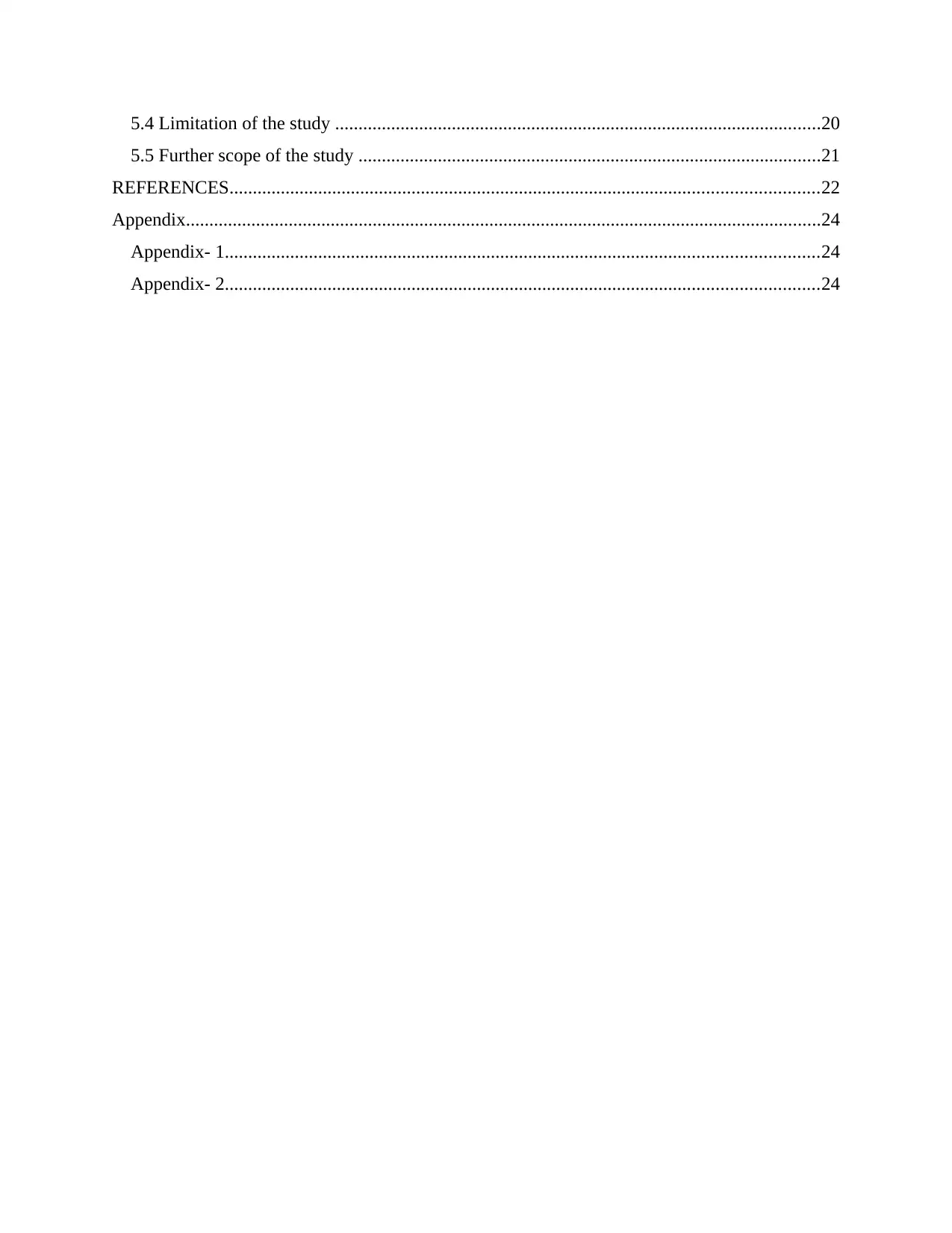
5.4 Limitation of the study ........................................................................................................20
5.5 Further scope of the study ...................................................................................................21
REFERENCES..............................................................................................................................22
Appendix........................................................................................................................................24
Appendix- 1...............................................................................................................................24
Appendix- 2...............................................................................................................................24
5.5 Further scope of the study ...................................................................................................21
REFERENCES..............................................................................................................................22
Appendix........................................................................................................................................24
Appendix- 1...............................................................................................................................24
Appendix- 2...............................................................................................................................24
⊘ This is a preview!⊘
Do you want full access?
Subscribe today to unlock all pages.

Trusted by 1+ million students worldwide
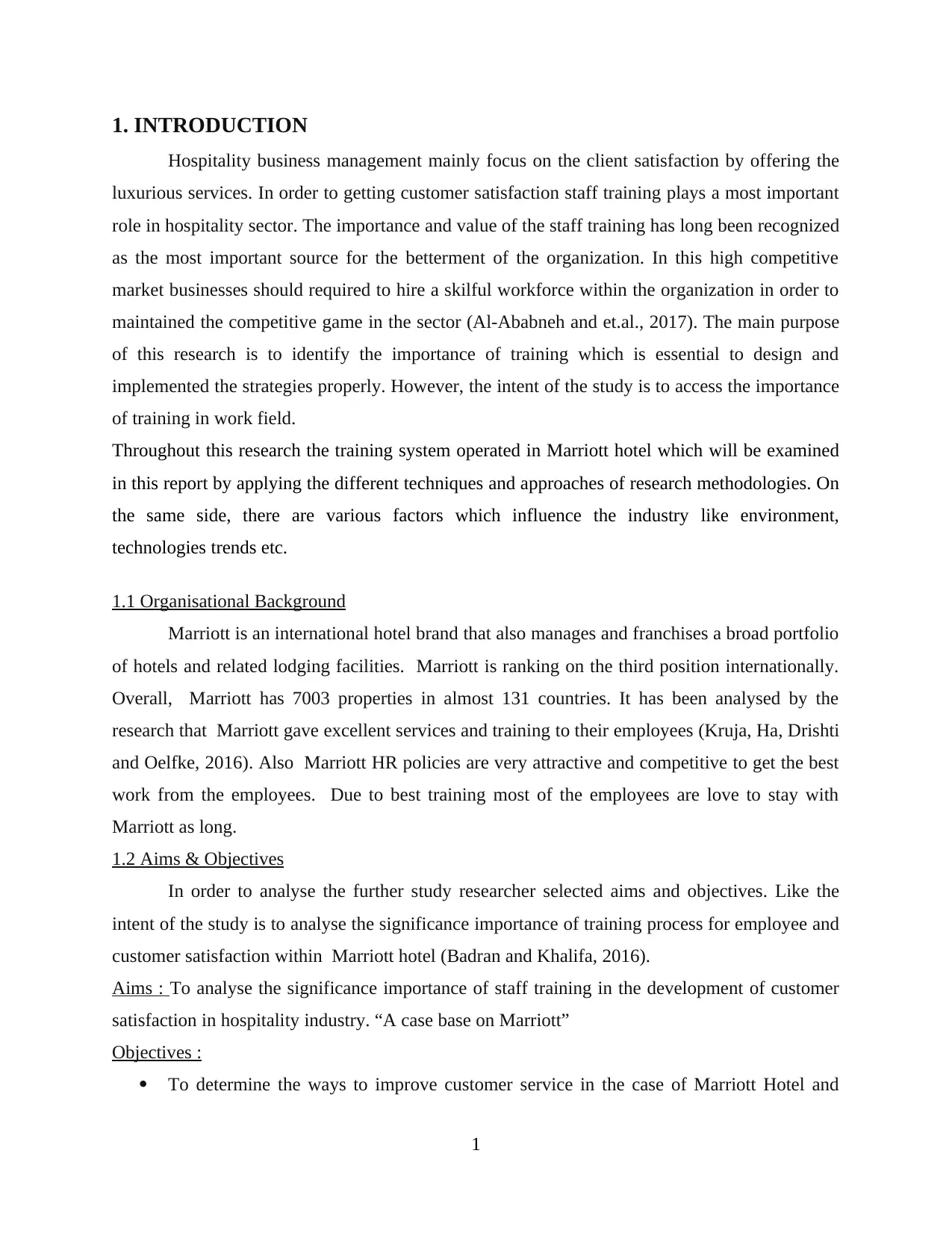
1. INTRODUCTION
Hospitality business management mainly focus on the client satisfaction by offering the
luxurious services. In order to getting customer satisfaction staff training plays a most important
role in hospitality sector. The importance and value of the staff training has long been recognized
as the most important source for the betterment of the organization. In this high competitive
market businesses should required to hire a skilful workforce within the organization in order to
maintained the competitive game in the sector (Al-Ababneh and et.al., 2017). The main purpose
of this research is to identify the importance of training which is essential to design and
implemented the strategies properly. However, the intent of the study is to access the importance
of training in work field.
Throughout this research the training system operated in Marriott hotel which will be examined
in this report by applying the different techniques and approaches of research methodologies. On
the same side, there are various factors which influence the industry like environment,
technologies trends etc.
1.1 Organisational Background
Marriott is an international hotel brand that also manages and franchises a broad portfolio
of hotels and related lodging facilities. Marriott is ranking on the third position internationally.
Overall, Marriott has 7003 properties in almost 131 countries. It has been analysed by the
research that Marriott gave excellent services and training to their employees (Kruja, Ha, Drishti
and Oelfke, 2016). Also Marriott HR policies are very attractive and competitive to get the best
work from the employees. Due to best training most of the employees are love to stay with
Marriott as long.
1.2 Aims & Objectives
In order to analyse the further study researcher selected aims and objectives. Like the
intent of the study is to analyse the significance importance of training process for employee and
customer satisfaction within Marriott hotel (Badran and Khalifa, 2016).
Aims : To analyse the significance importance of staff training in the development of customer
satisfaction in hospitality industry. “A case base on Marriott”
Objectives :
To determine the ways to improve customer service in the case of Marriott Hotel and
1
Hospitality business management mainly focus on the client satisfaction by offering the
luxurious services. In order to getting customer satisfaction staff training plays a most important
role in hospitality sector. The importance and value of the staff training has long been recognized
as the most important source for the betterment of the organization. In this high competitive
market businesses should required to hire a skilful workforce within the organization in order to
maintained the competitive game in the sector (Al-Ababneh and et.al., 2017). The main purpose
of this research is to identify the importance of training which is essential to design and
implemented the strategies properly. However, the intent of the study is to access the importance
of training in work field.
Throughout this research the training system operated in Marriott hotel which will be examined
in this report by applying the different techniques and approaches of research methodologies. On
the same side, there are various factors which influence the industry like environment,
technologies trends etc.
1.1 Organisational Background
Marriott is an international hotel brand that also manages and franchises a broad portfolio
of hotels and related lodging facilities. Marriott is ranking on the third position internationally.
Overall, Marriott has 7003 properties in almost 131 countries. It has been analysed by the
research that Marriott gave excellent services and training to their employees (Kruja, Ha, Drishti
and Oelfke, 2016). Also Marriott HR policies are very attractive and competitive to get the best
work from the employees. Due to best training most of the employees are love to stay with
Marriott as long.
1.2 Aims & Objectives
In order to analyse the further study researcher selected aims and objectives. Like the
intent of the study is to analyse the significance importance of training process for employee and
customer satisfaction within Marriott hotel (Badran and Khalifa, 2016).
Aims : To analyse the significance importance of staff training in the development of customer
satisfaction in hospitality industry. “A case base on Marriott”
Objectives :
To determine the ways to improve customer service in the case of Marriott Hotel and
1
Paraphrase This Document
Need a fresh take? Get an instant paraphrase of this document with our AI Paraphraser
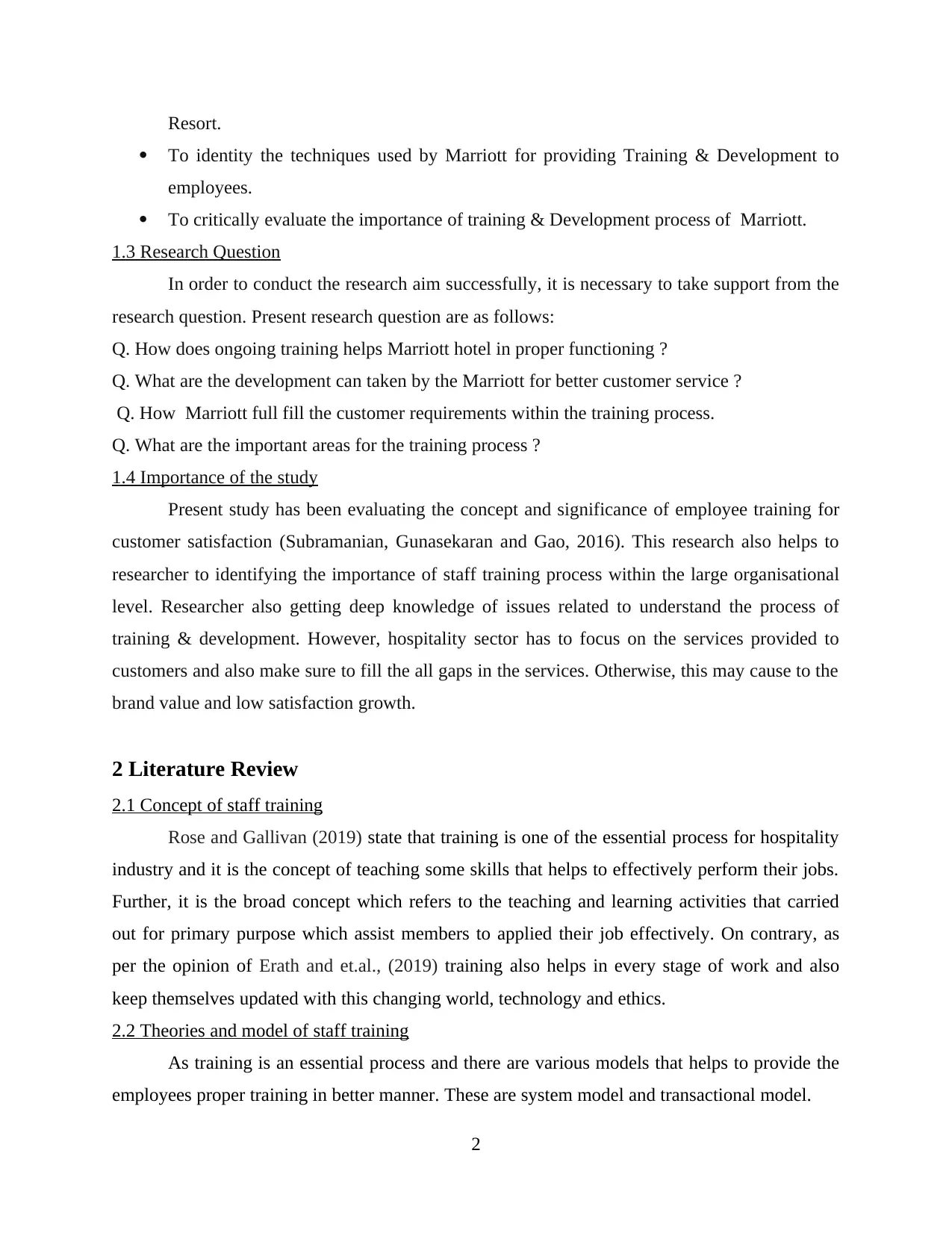
Resort.
To identity the techniques used by Marriott for providing Training & Development to
employees.
To critically evaluate the importance of training & Development process of Marriott.
1.3 Research Question
In order to conduct the research aim successfully, it is necessary to take support from the
research question. Present research question are as follows:
Q. How does ongoing training helps Marriott hotel in proper functioning ?
Q. What are the development can taken by the Marriott for better customer service ?
Q. How Marriott full fill the customer requirements within the training process.
Q. What are the important areas for the training process ?
1.4 Importance of the study
Present study has been evaluating the concept and significance of employee training for
customer satisfaction (Subramanian, Gunasekaran and Gao, 2016). This research also helps to
researcher to identifying the importance of staff training process within the large organisational
level. Researcher also getting deep knowledge of issues related to understand the process of
training & development. However, hospitality sector has to focus on the services provided to
customers and also make sure to fill the all gaps in the services. Otherwise, this may cause to the
brand value and low satisfaction growth.
2 Literature Review
2.1 Concept of staff training
Rose and Gallivan (2019) state that training is one of the essential process for hospitality
industry and it is the concept of teaching some skills that helps to effectively perform their jobs.
Further, it is the broad concept which refers to the teaching and learning activities that carried
out for primary purpose which assist members to applied their job effectively. On contrary, as
per the opinion of Erath and et.al., (2019) training also helps in every stage of work and also
keep themselves updated with this changing world, technology and ethics.
2.2 Theories and model of staff training
As training is an essential process and there are various models that helps to provide the
employees proper training in better manner. These are system model and transactional model.
2
To identity the techniques used by Marriott for providing Training & Development to
employees.
To critically evaluate the importance of training & Development process of Marriott.
1.3 Research Question
In order to conduct the research aim successfully, it is necessary to take support from the
research question. Present research question are as follows:
Q. How does ongoing training helps Marriott hotel in proper functioning ?
Q. What are the development can taken by the Marriott for better customer service ?
Q. How Marriott full fill the customer requirements within the training process.
Q. What are the important areas for the training process ?
1.4 Importance of the study
Present study has been evaluating the concept and significance of employee training for
customer satisfaction (Subramanian, Gunasekaran and Gao, 2016). This research also helps to
researcher to identifying the importance of staff training process within the large organisational
level. Researcher also getting deep knowledge of issues related to understand the process of
training & development. However, hospitality sector has to focus on the services provided to
customers and also make sure to fill the all gaps in the services. Otherwise, this may cause to the
brand value and low satisfaction growth.
2 Literature Review
2.1 Concept of staff training
Rose and Gallivan (2019) state that training is one of the essential process for hospitality
industry and it is the concept of teaching some skills that helps to effectively perform their jobs.
Further, it is the broad concept which refers to the teaching and learning activities that carried
out for primary purpose which assist members to applied their job effectively. On contrary, as
per the opinion of Erath and et.al., (2019) training also helps in every stage of work and also
keep themselves updated with this changing world, technology and ethics.
2.2 Theories and model of staff training
As training is an essential process and there are various models that helps to provide the
employees proper training in better manner. These are system model and transactional model.
2
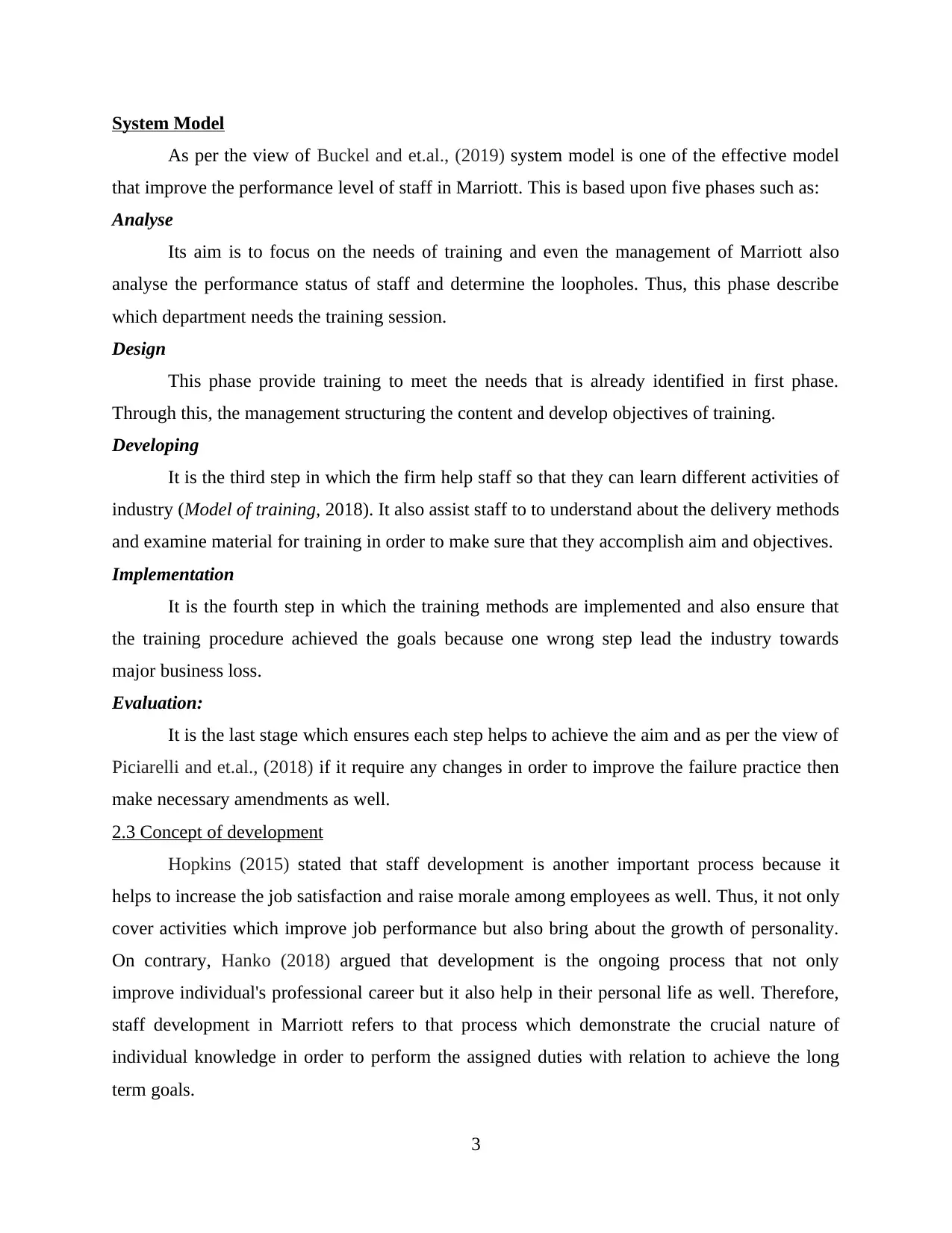
System Model
As per the view of Buckel and et.al., (2019) system model is one of the effective model
that improve the performance level of staff in Marriott. This is based upon five phases such as:
Analyse
Its aim is to focus on the needs of training and even the management of Marriott also
analyse the performance status of staff and determine the loopholes. Thus, this phase describe
which department needs the training session.
Design
This phase provide training to meet the needs that is already identified in first phase.
Through this, the management structuring the content and develop objectives of training.
Developing
It is the third step in which the firm help staff so that they can learn different activities of
industry (Model of training, 2018). It also assist staff to to understand about the delivery methods
and examine material for training in order to make sure that they accomplish aim and objectives.
Implementation
It is the fourth step in which the training methods are implemented and also ensure that
the training procedure achieved the goals because one wrong step lead the industry towards
major business loss.
Evaluation:
It is the last stage which ensures each step helps to achieve the aim and as per the view of
Piciarelli and et.al., (2018) if it require any changes in order to improve the failure practice then
make necessary amendments as well.
2.3 Concept of development
Hopkins (2015) stated that staff development is another important process because it
helps to increase the job satisfaction and raise morale among employees as well. Thus, it not only
cover activities which improve job performance but also bring about the growth of personality.
On contrary, Hanko (2018) argued that development is the ongoing process that not only
improve individual's professional career but it also help in their personal life as well. Therefore,
staff development in Marriott refers to that process which demonstrate the crucial nature of
individual knowledge in order to perform the assigned duties with relation to achieve the long
term goals.
3
As per the view of Buckel and et.al., (2019) system model is one of the effective model
that improve the performance level of staff in Marriott. This is based upon five phases such as:
Analyse
Its aim is to focus on the needs of training and even the management of Marriott also
analyse the performance status of staff and determine the loopholes. Thus, this phase describe
which department needs the training session.
Design
This phase provide training to meet the needs that is already identified in first phase.
Through this, the management structuring the content and develop objectives of training.
Developing
It is the third step in which the firm help staff so that they can learn different activities of
industry (Model of training, 2018). It also assist staff to to understand about the delivery methods
and examine material for training in order to make sure that they accomplish aim and objectives.
Implementation
It is the fourth step in which the training methods are implemented and also ensure that
the training procedure achieved the goals because one wrong step lead the industry towards
major business loss.
Evaluation:
It is the last stage which ensures each step helps to achieve the aim and as per the view of
Piciarelli and et.al., (2018) if it require any changes in order to improve the failure practice then
make necessary amendments as well.
2.3 Concept of development
Hopkins (2015) stated that staff development is another important process because it
helps to increase the job satisfaction and raise morale among employees as well. Thus, it not only
cover activities which improve job performance but also bring about the growth of personality.
On contrary, Hanko (2018) argued that development is the ongoing process that not only
improve individual's professional career but it also help in their personal life as well. Therefore,
staff development in Marriott refers to that process which demonstrate the crucial nature of
individual knowledge in order to perform the assigned duties with relation to achieve the long
term goals.
3
⊘ This is a preview!⊘
Do you want full access?
Subscribe today to unlock all pages.

Trusted by 1+ million students worldwide
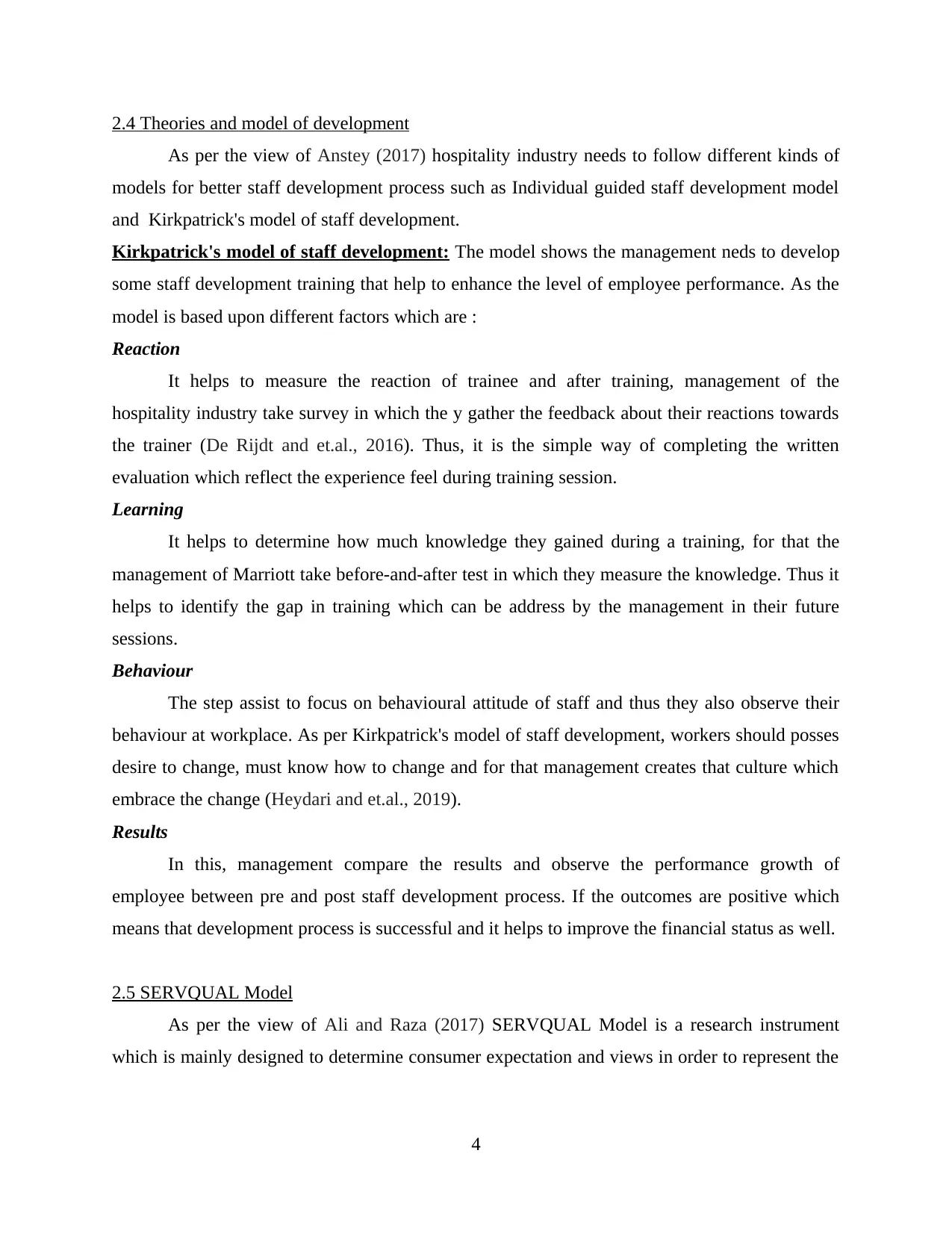
2.4 Theories and model of development
As per the view of Anstey (2017) hospitality industry needs to follow different kinds of
models for better staff development process such as Individual guided staff development model
and Kirkpatrick's model of staff development.
Kirkpatrick's model of staff development: The model shows the management neds to develop
some staff development training that help to enhance the level of employee performance. As the
model is based upon different factors which are :
Reaction
It helps to measure the reaction of trainee and after training, management of the
hospitality industry take survey in which the y gather the feedback about their reactions towards
the trainer (De Rijdt and et.al., 2016). Thus, it is the simple way of completing the written
evaluation which reflect the experience feel during training session.
Learning
It helps to determine how much knowledge they gained during a training, for that the
management of Marriott take before-and-after test in which they measure the knowledge. Thus it
helps to identify the gap in training which can be address by the management in their future
sessions.
Behaviour
The step assist to focus on behavioural attitude of staff and thus they also observe their
behaviour at workplace. As per Kirkpatrick's model of staff development, workers should posses
desire to change, must know how to change and for that management creates that culture which
embrace the change (Heydari and et.al., 2019).
Results
In this, management compare the results and observe the performance growth of
employee between pre and post staff development process. If the outcomes are positive which
means that development process is successful and it helps to improve the financial status as well.
2.5 SERVQUAL Model
As per the view of Ali and Raza (2017) SERVQUAL Model is a research instrument
which is mainly designed to determine consumer expectation and views in order to represent the
4
As per the view of Anstey (2017) hospitality industry needs to follow different kinds of
models for better staff development process such as Individual guided staff development model
and Kirkpatrick's model of staff development.
Kirkpatrick's model of staff development: The model shows the management neds to develop
some staff development training that help to enhance the level of employee performance. As the
model is based upon different factors which are :
Reaction
It helps to measure the reaction of trainee and after training, management of the
hospitality industry take survey in which the y gather the feedback about their reactions towards
the trainer (De Rijdt and et.al., 2016). Thus, it is the simple way of completing the written
evaluation which reflect the experience feel during training session.
Learning
It helps to determine how much knowledge they gained during a training, for that the
management of Marriott take before-and-after test in which they measure the knowledge. Thus it
helps to identify the gap in training which can be address by the management in their future
sessions.
Behaviour
The step assist to focus on behavioural attitude of staff and thus they also observe their
behaviour at workplace. As per Kirkpatrick's model of staff development, workers should posses
desire to change, must know how to change and for that management creates that culture which
embrace the change (Heydari and et.al., 2019).
Results
In this, management compare the results and observe the performance growth of
employee between pre and post staff development process. If the outcomes are positive which
means that development process is successful and it helps to improve the financial status as well.
2.5 SERVQUAL Model
As per the view of Ali and Raza (2017) SERVQUAL Model is a research instrument
which is mainly designed to determine consumer expectation and views in order to represent the
4
Paraphrase This Document
Need a fresh take? Get an instant paraphrase of this document with our AI Paraphraser
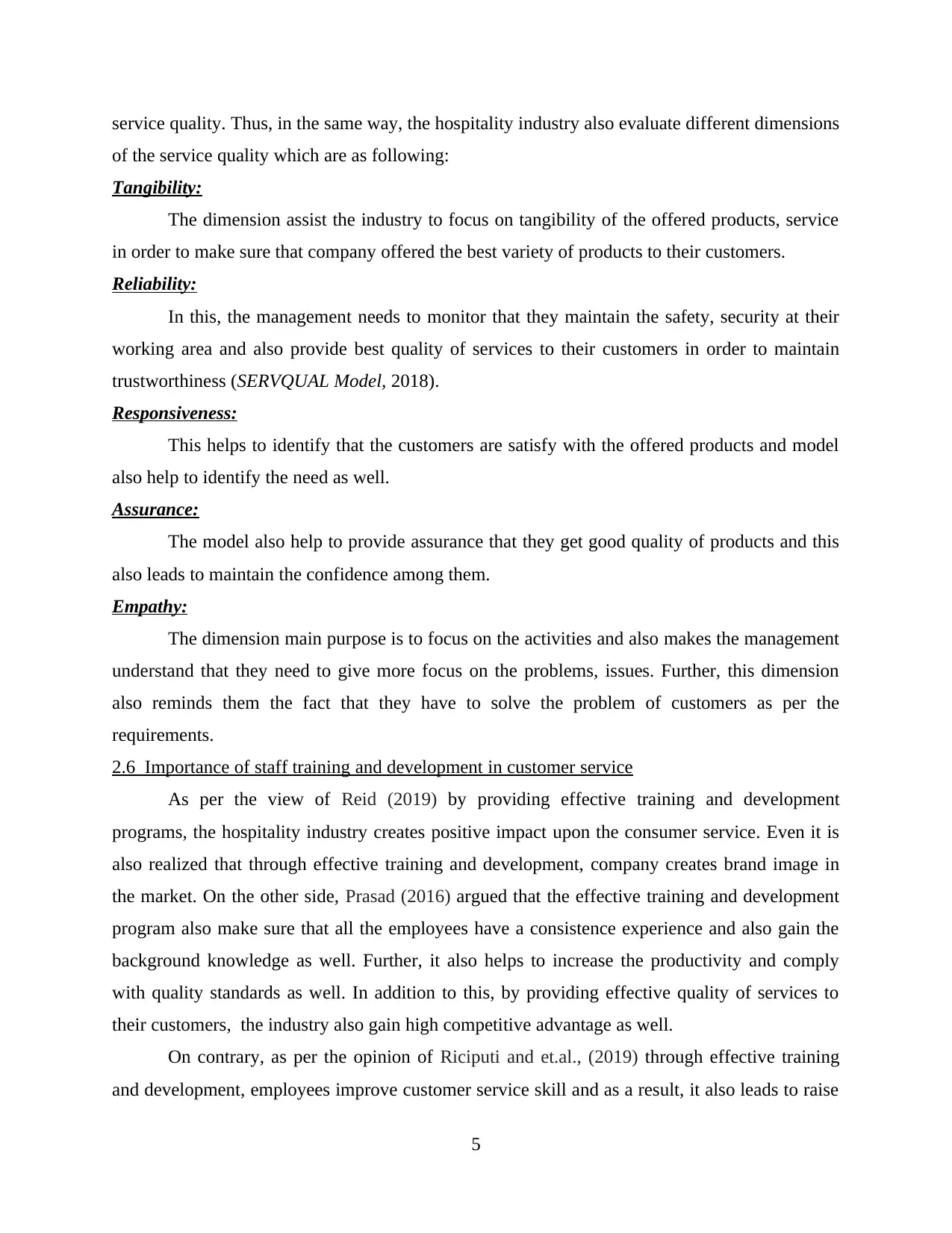
service quality. Thus, in the same way, the hospitality industry also evaluate different dimensions
of the service quality which are as following:
Tangibility:
The dimension assist the industry to focus on tangibility of the offered products, service
in order to make sure that company offered the best variety of products to their customers.
Reliability:
In this, the management needs to monitor that they maintain the safety, security at their
working area and also provide best quality of services to their customers in order to maintain
trustworthiness (SERVQUAL Model, 2018).
Responsiveness:
This helps to identify that the customers are satisfy with the offered products and model
also help to identify the need as well.
Assurance:
The model also help to provide assurance that they get good quality of products and this
also leads to maintain the confidence among them.
Empathy:
The dimension main purpose is to focus on the activities and also makes the management
understand that they need to give more focus on the problems, issues. Further, this dimension
also reminds them the fact that they have to solve the problem of customers as per the
requirements.
2.6 Importance of staff training and development in customer service
As per the view of Reid (2019) by providing effective training and development
programs, the hospitality industry creates positive impact upon the consumer service. Even it is
also realized that through effective training and development, company creates brand image in
the market. On the other side, Prasad (2016) argued that the effective training and development
program also make sure that all the employees have a consistence experience and also gain the
background knowledge as well. Further, it also helps to increase the productivity and comply
with quality standards as well. In addition to this, by providing effective quality of services to
their customers, the industry also gain high competitive advantage as well.
On contrary, as per the opinion of Riciputi and et.al., (2019) through effective training
and development, employees improve customer service skill and as a result, it also leads to raise
5
of the service quality which are as following:
Tangibility:
The dimension assist the industry to focus on tangibility of the offered products, service
in order to make sure that company offered the best variety of products to their customers.
Reliability:
In this, the management needs to monitor that they maintain the safety, security at their
working area and also provide best quality of services to their customers in order to maintain
trustworthiness (SERVQUAL Model, 2018).
Responsiveness:
This helps to identify that the customers are satisfy with the offered products and model
also help to identify the need as well.
Assurance:
The model also help to provide assurance that they get good quality of products and this
also leads to maintain the confidence among them.
Empathy:
The dimension main purpose is to focus on the activities and also makes the management
understand that they need to give more focus on the problems, issues. Further, this dimension
also reminds them the fact that they have to solve the problem of customers as per the
requirements.
2.6 Importance of staff training and development in customer service
As per the view of Reid (2019) by providing effective training and development
programs, the hospitality industry creates positive impact upon the consumer service. Even it is
also realized that through effective training and development, company creates brand image in
the market. On the other side, Prasad (2016) argued that the effective training and development
program also make sure that all the employees have a consistence experience and also gain the
background knowledge as well. Further, it also helps to increase the productivity and comply
with quality standards as well. In addition to this, by providing effective quality of services to
their customers, the industry also gain high competitive advantage as well.
On contrary, as per the opinion of Riciputi and et.al., (2019) through effective training
and development, employees improve customer service skill and as a result, it also leads to raise
5
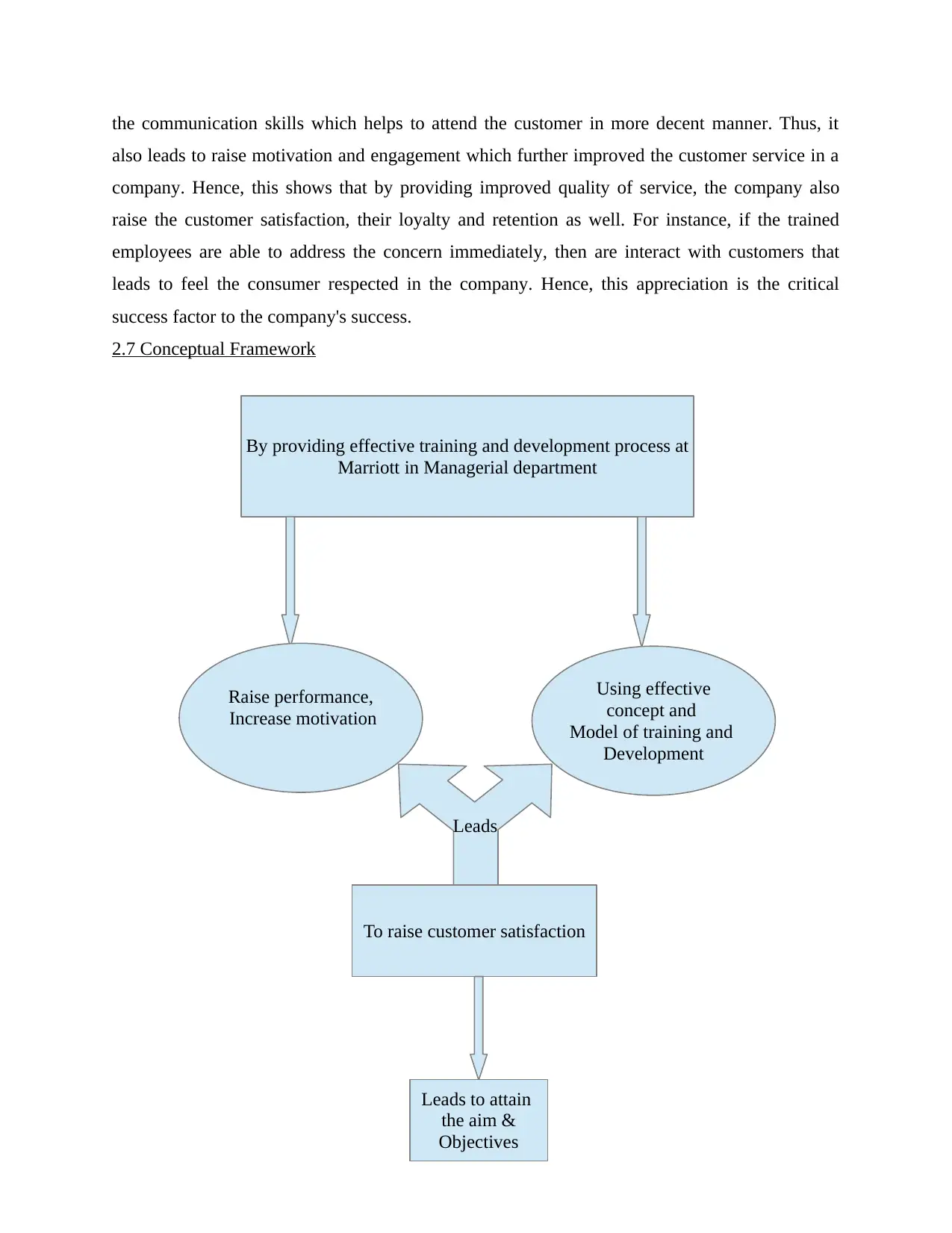
the communication skills which helps to attend the customer in more decent manner. Thus, it
also leads to raise motivation and engagement which further improved the customer service in a
company. Hence, this shows that by providing improved quality of service, the company also
raise the customer satisfaction, their loyalty and retention as well. For instance, if the trained
employees are able to address the concern immediately, then are interact with customers that
leads to feel the consumer respected in the company. Hence, this appreciation is the critical
success factor to the company's success.
2.7 Conceptual Framework
6
By providing effective training and development process at
Marriott in Managerial department
Raise performance,
Increase motivation
Using effective
concept and
Model of training and
Development
Leads
To raise customer satisfaction
Leads to attain
the aim &
Objectives
also leads to raise motivation and engagement which further improved the customer service in a
company. Hence, this shows that by providing improved quality of service, the company also
raise the customer satisfaction, their loyalty and retention as well. For instance, if the trained
employees are able to address the concern immediately, then are interact with customers that
leads to feel the consumer respected in the company. Hence, this appreciation is the critical
success factor to the company's success.
2.7 Conceptual Framework
6
By providing effective training and development process at
Marriott in Managerial department
Raise performance,
Increase motivation
Using effective
concept and
Model of training and
Development
Leads
To raise customer satisfaction
Leads to attain
the aim &
Objectives
⊘ This is a preview!⊘
Do you want full access?
Subscribe today to unlock all pages.

Trusted by 1+ million students worldwide
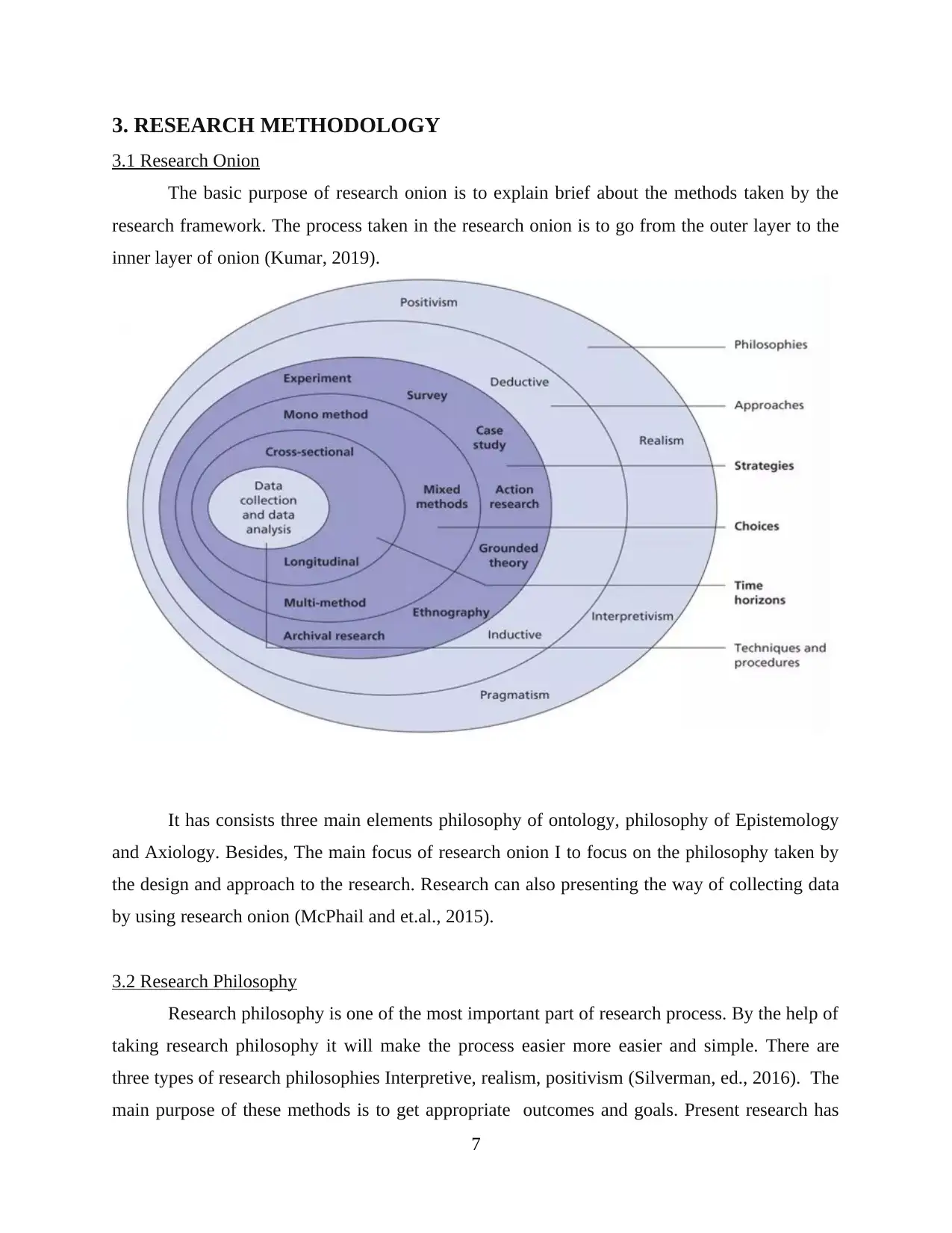
3. RESEARCH METHODOLOGY
3.1 Research Onion
The basic purpose of research onion is to explain brief about the methods taken by the
research framework. The process taken in the research onion is to go from the outer layer to the
inner layer of onion (Kumar, 2019).
It has consists three main elements philosophy of ontology, philosophy of Epistemology
and Axiology. Besides, The main focus of research onion I to focus on the philosophy taken by
the design and approach to the research. Research can also presenting the way of collecting data
by using research onion (McPhail and et.al., 2015).
3.2 Research Philosophy
Research philosophy is one of the most important part of research process. By the help of
taking research philosophy it will make the process easier more easier and simple. There are
three types of research philosophies Interpretive, realism, positivism (Silverman, ed., 2016). The
main purpose of these methods is to get appropriate outcomes and goals. Present research has
7
3.1 Research Onion
The basic purpose of research onion is to explain brief about the methods taken by the
research framework. The process taken in the research onion is to go from the outer layer to the
inner layer of onion (Kumar, 2019).
It has consists three main elements philosophy of ontology, philosophy of Epistemology
and Axiology. Besides, The main focus of research onion I to focus on the philosophy taken by
the design and approach to the research. Research can also presenting the way of collecting data
by using research onion (McPhail and et.al., 2015).
3.2 Research Philosophy
Research philosophy is one of the most important part of research process. By the help of
taking research philosophy it will make the process easier more easier and simple. There are
three types of research philosophies Interpretive, realism, positivism (Silverman, ed., 2016). The
main purpose of these methods is to get appropriate outcomes and goals. Present research has
7
Paraphrase This Document
Need a fresh take? Get an instant paraphrase of this document with our AI Paraphraser
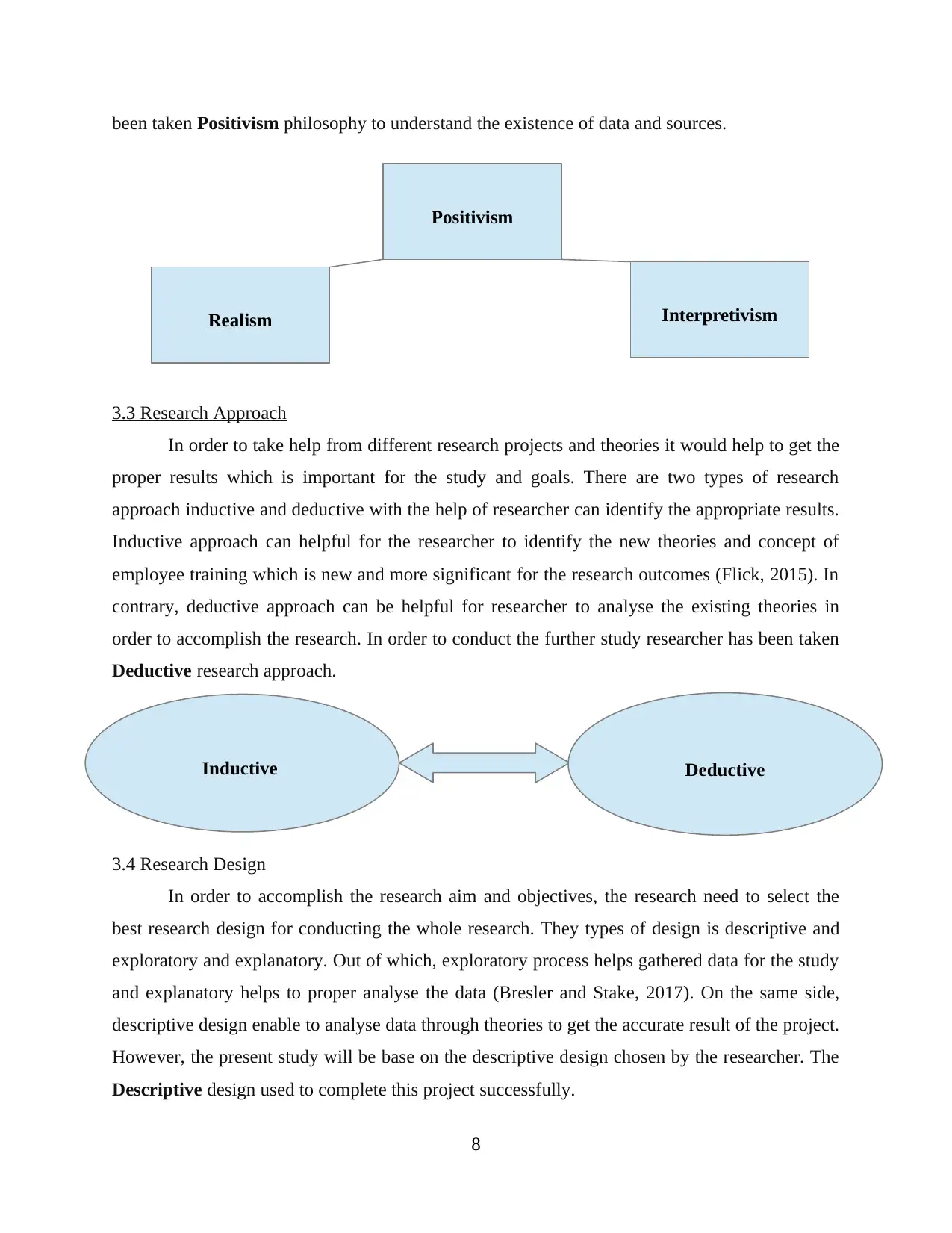
been taken Positivism philosophy to understand the existence of data and sources.
3.3 Research Approach
In order to take help from different research projects and theories it would help to get the
proper results which is important for the study and goals. There are two types of research
approach inductive and deductive with the help of researcher can identify the appropriate results.
Inductive approach can helpful for the researcher to identify the new theories and concept of
employee training which is new and more significant for the research outcomes (Flick, 2015). In
contrary, deductive approach can be helpful for researcher to analyse the existing theories in
order to accomplish the research. In order to conduct the further study researcher has been taken
Deductive research approach.
3.4 Research Design
In order to accomplish the research aim and objectives, the research need to select the
best research design for conducting the whole research. They types of design is descriptive and
exploratory and explanatory. Out of which, exploratory process helps gathered data for the study
and explanatory helps to proper analyse the data (Bresler and Stake, 2017). On the same side,
descriptive design enable to analyse data through theories to get the accurate result of the project.
However, the present study will be base on the descriptive design chosen by the researcher. The
Descriptive design used to complete this project successfully.
8
Inductive Deductive
Positivism
Realism Interpretivism
3.3 Research Approach
In order to take help from different research projects and theories it would help to get the
proper results which is important for the study and goals. There are two types of research
approach inductive and deductive with the help of researcher can identify the appropriate results.
Inductive approach can helpful for the researcher to identify the new theories and concept of
employee training which is new and more significant for the research outcomes (Flick, 2015). In
contrary, deductive approach can be helpful for researcher to analyse the existing theories in
order to accomplish the research. In order to conduct the further study researcher has been taken
Deductive research approach.
3.4 Research Design
In order to accomplish the research aim and objectives, the research need to select the
best research design for conducting the whole research. They types of design is descriptive and
exploratory and explanatory. Out of which, exploratory process helps gathered data for the study
and explanatory helps to proper analyse the data (Bresler and Stake, 2017). On the same side,
descriptive design enable to analyse data through theories to get the accurate result of the project.
However, the present study will be base on the descriptive design chosen by the researcher. The
Descriptive design used to complete this project successfully.
8
Inductive Deductive
Positivism
Realism Interpretivism
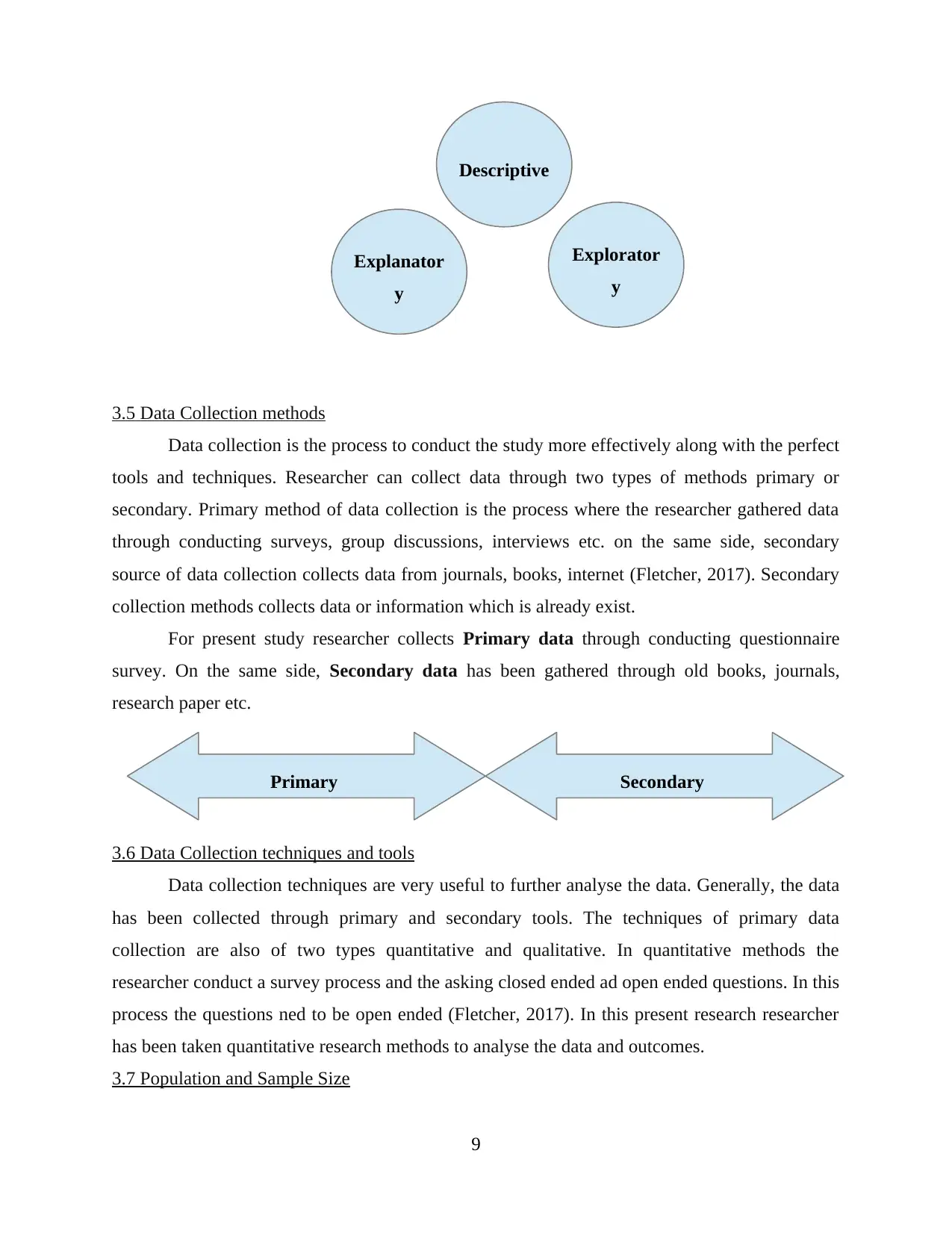
3.5 Data Collection methods
Data collection is the process to conduct the study more effectively along with the perfect
tools and techniques. Researcher can collect data through two types of methods primary or
secondary. Primary method of data collection is the process where the researcher gathered data
through conducting surveys, group discussions, interviews etc. on the same side, secondary
source of data collection collects data from journals, books, internet (Fletcher, 2017). Secondary
collection methods collects data or information which is already exist.
For present study researcher collects Primary data through conducting questionnaire
survey. On the same side, Secondary data has been gathered through old books, journals,
research paper etc.
3.6 Data Collection techniques and tools
Data collection techniques are very useful to further analyse the data. Generally, the data
has been collected through primary and secondary tools. The techniques of primary data
collection are also of two types quantitative and qualitative. In quantitative methods the
researcher conduct a survey process and the asking closed ended ad open ended questions. In this
process the questions ned to be open ended (Fletcher, 2017). In this present research researcher
has been taken quantitative research methods to analyse the data and outcomes.
3.7 Population and Sample Size
9
Descriptive
Explanator
y
Explorator
y
Primary Secondary
Data collection is the process to conduct the study more effectively along with the perfect
tools and techniques. Researcher can collect data through two types of methods primary or
secondary. Primary method of data collection is the process where the researcher gathered data
through conducting surveys, group discussions, interviews etc. on the same side, secondary
source of data collection collects data from journals, books, internet (Fletcher, 2017). Secondary
collection methods collects data or information which is already exist.
For present study researcher collects Primary data through conducting questionnaire
survey. On the same side, Secondary data has been gathered through old books, journals,
research paper etc.
3.6 Data Collection techniques and tools
Data collection techniques are very useful to further analyse the data. Generally, the data
has been collected through primary and secondary tools. The techniques of primary data
collection are also of two types quantitative and qualitative. In quantitative methods the
researcher conduct a survey process and the asking closed ended ad open ended questions. In this
process the questions ned to be open ended (Fletcher, 2017). In this present research researcher
has been taken quantitative research methods to analyse the data and outcomes.
3.7 Population and Sample Size
9
Descriptive
Explanator
y
Explorator
y
Primary Secondary
⊘ This is a preview!⊘
Do you want full access?
Subscribe today to unlock all pages.

Trusted by 1+ million students worldwide
1 out of 29
Related Documents
Your All-in-One AI-Powered Toolkit for Academic Success.
+13062052269
info@desklib.com
Available 24*7 on WhatsApp / Email
![[object Object]](/_next/static/media/star-bottom.7253800d.svg)
Unlock your academic potential
Copyright © 2020–2025 A2Z Services. All Rights Reserved. Developed and managed by ZUCOL.





